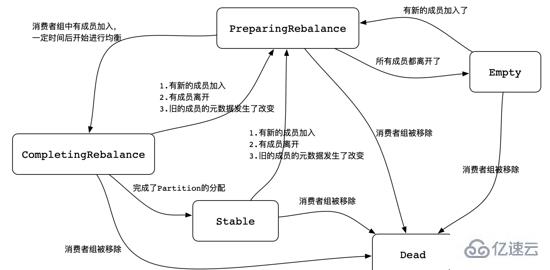жӮЁеҘҪпјҢзҷ»еҪ•еҗҺжүҚиғҪдёӢи®ўеҚ•е“ҰпјҒ
жӮЁеҘҪпјҢзҷ»еҪ•еҗҺжүҚиғҪдёӢи®ўеҚ•е“ҰпјҒ
иҝҷзҜҮвҖңKafkaеҝғи·ідёҺж¶Ҳиҙ№жңәеҲ¶жҳҜд»Җд№ҲвҖқж–Үз« зҡ„зҹҘиҜҶзӮ№еӨ§йғЁеҲҶдәәйғҪдёҚеӨӘзҗҶи§ЈпјҢжүҖд»Ҙе°Ҹзј–з»ҷеӨ§е®¶жҖ»з»“дәҶд»ҘдёӢеҶ…е®№пјҢеҶ…е®№иҜҰз»ҶпјҢжӯҘйӘӨжё…жҷ°пјҢе…·жңүдёҖе®ҡзҡ„еҖҹйүҙд»·еҖјпјҢеёҢжңӣеӨ§е®¶йҳ…иҜ»е®ҢиҝҷзҜҮж–Үз« иғҪжңүжүҖ收иҺ·пјҢдёӢйқўжҲ‘们дёҖиө·жқҘзңӢзңӢиҝҷзҜҮвҖңKafkaеҝғи·ідёҺж¶Ҳиҙ№жңәеҲ¶жҳҜд»Җд№ҲвҖқж–Үз« еҗ§гҖӮ
KafkaжҳҜйҖҡиҝҮеҝғи·іжңәеҲ¶жқҘжҺ§еҲ¶ж¶Ҳиҙ№и¶…ж—¶пјҢеҝғи·іжңәеҲ¶еҜ№дәҺж¶Ҳиҙ№иҖ…е®ўжҲ·з«ҜжқҘиҜҙжҳҜж— ж„ҹзҡ„пјҢе®ғжҳҜдёҖдёӘејӮжӯҘзәҝзЁӢпјҢеҪ“жҲ‘们еҗҜеҠЁдёҖдёӘж¶Ҳиҙ№иҖ…е®һдҫӢж—¶пјҢеҝғи·ізәҝзЁӢе°ұејҖе§Ӣе·ҘдҪңдәҶгҖӮеҝғи·іи¶…ж—¶дјҡеҜјиҮҙж¶ҲжҒҜйҮҚеӨҚж¶Ҳиҙ№гҖӮ

йҰ–е…ҲпјҢжҲ‘们жқҘзңӢзңӢж¶Ҳиҙ№гҖӮKafkaжҸҗдҫӣдәҶйқһеёёз®ҖеҚ•зҡ„ж¶Ҳиҙ№APIпјҢдҪҝз”ЁиҖ…еҸӘйңҖеҲқе§ӢеҢ–Kafkaзҡ„Broker Serverең°еқҖпјҢ然еҗҺе®һдҫӢеҢ–KafkaConsumerзұ»еҚіеҸҜжӢҝеҲ°Topicдёӯзҡ„ж•°жҚ®гҖӮдёҖдёӘз®ҖеҚ•зҡ„Kafkaж¶Ҳиҙ№е®һдҫӢд»Јз ҒеҰӮдёӢжүҖзӨәпјҡ
public class JConsumerSubscribe extends Thread {
public static void main(String[] args) { JConsumerSubscribe jconsumer = new JConsumerSubscribe(); jconsumer.start(); } /** еҲқе§ӢеҢ–KafkaйӣҶзҫӨдҝЎжҒҜ. */ private Properties configure() { Properties props = new Properties(); props.put("bootstrap.servers", "dn1:9092,dn2:9092,dn3:9092");// жҢҮе®ҡKafkaйӣҶзҫӨең°еқҖ
props.put("group.id", "ke");// жҢҮе®ҡж¶Ҳиҙ№иҖ…з»„
props.put("enable.auto.commit", "true");// ејҖеҗҜиҮӘеҠЁжҸҗдәӨ
props.put("auto.commit.interval.ms", "1000");// иҮӘеҠЁжҸҗдәӨзҡ„ж—¶й—ҙй—ҙйҡ”
// еҸҚеәҸеҲ—еҢ–ж¶ҲжҒҜдё»й”® props.put("key.deserializer", "org.apache.kafka.common.serialization.StringDeserializer");
// еҸҚеәҸеҲ—еҢ–ж¶Ҳиҙ№и®°еҪ• props.put("value.deserializer", "org.apache.kafka.common.serialization.StringDeserializer");
return props;
} /** е®һзҺ°дёҖдёӘеҚ•зәҝзЁӢж¶Ҳиҙ№иҖ…. */ @Override public void run() { // еҲӣе»әдёҖдёӘж¶Ҳиҙ№иҖ…е®һдҫӢеҜ№иұЎ KafkaConsumer consumer = new KafkaConsumer(configure()); // и®ўйҳ…ж¶Ҳиҙ№дё»йўҳйӣҶеҗҲ consumer.subscribe(Arrays.asList("test_kafka_topic"));
// е®һж—¶ж¶Ҳиҙ№ж ҮиҜҶ boolean flag = true;
while (flag) {
// иҺ·еҸ–дё»йўҳж¶ҲжҒҜж•°жҚ® ConsumerRecords records = consumer.poll(Duration.ofMillis(100));
for (ConsumerRecord record : records)
// еҫӘзҺҜжү“еҚ°ж¶ҲжҒҜи®°еҪ• System.out.printf("offset = %d, key = %s, value = %s%n", record.offset(), record.key(), record.value());
} // еҮәзҺ°ејӮеёёе…ій—ӯж¶Ҳиҙ№иҖ…еҜ№иұЎ consumer.close();
}}дёҠиҝ°д»Јз ҒжҲ‘们е°ұеҸҜд»ҘйқһеёёдҫҝжҚ·зҡ„жӢҝеҲ°Topicдёӯзҡ„ж•°жҚ®гҖӮдҪҶжҳҜпјҢеҪ“жҲ‘们и°ғз”Ёpollж–№жі•жӢүеҸ–ж•°жҚ®зҡ„ж—¶еҖҷпјҢKafka Broker ServerеҒҡдәҶйӮЈдәӣдәӢжғ…гҖӮжҺҘдёӢжқҘпјҢжҲ‘们еҸҜд»ҘеҺ»зңӢзңӢжәҗд»Јз Ғзҡ„е®һзҺ°з»ҶиҠӮгҖӮж ёеҝғд»Јз ҒеҰӮдёӢпјҡ org.apache.kafka.clients.consumer.KafkaConsumer
private ConsumerRecords poll(final long timeoutMs, final boolean includeMetadataInTimeout) {
acquireAndEnsureOpen(); try {
if (timeoutMs "Timeout must not be negative");
if (this.subscriptions.hasNoSubscriptionOrUserAssignment()) {
throw new IllegalStateException("Consumer is not subscribed to any topics or assigned any partitions");
} // poll for new data until the timeout expires
long elapsedTime = 0L;
do {
client.maybeTriggerWakeup(); final long metadataEnd; if (includeMetadataInTimeout) {
final long metadataStart = time.milliseconds(); if (!updateAssignmentMetadataIfNeeded(remainingTimeAtLeastZero(timeoutMs, elapsedTime))) {
return ConsumerRecords.empty();
} metadataEnd = time.milliseconds(); elapsedTime += metadataEnd - metadataStart; } else {
while (!updateAssignmentMetadataIfNeeded(Long.MAX_VALUE)) {
log.warn("Still waiting for metadata");
} metadataEnd = time.milliseconds(); } final Map>> records = pollForFetches(remainingTimeAtLeastZero(timeoutMs, elapsedTime)); if (!records.isEmpty()) {
// before returning the fetched records, we can send off the next round of fetches
// and avoid block waiting for their responses to enable pipelining while the user
// is handling the fetched records.
//
// NOTE: since the consumed position has already been updated, we must not allow
// wakeups or any other errors to be triggered prior to returning the fetched records.
if (fetcher.sendFetches() > 0 || client.hasPendingRequests()) {
client.pollNoWakeup(); } return this.interceptors.onConsume(new ConsumerRecords(records));
} final long fetchEnd = time.milliseconds(); elapsedTime += fetchEnd - metadataEnd; } while (elapsedTime return ConsumerRecords.empty();
} finally {
release(); } }дёҠиҝ°д»Јз ҒдёӯжңүдёӘж–№жі•pollForFetchesпјҢе®ғзҡ„е®һзҺ°йҖ»иҫ‘еҰӮдёӢпјҡ
private Map>> pollForFetches(final long timeoutMs) {
final long startMs = time.milliseconds();
long pollTimeout = Math.min(coordinator.timeToNextPoll(startMs), timeoutMs);
// if data is available already, return it immediately
final Map>> records = fetcher.fetchedRecords();
if (!records.isEmpty()) {
return records;
}
// send any new fetches (won't resend pending fetches)
fetcher.sendFetches();
// We do not want to be stuck blocking in poll if we are missing some positions
// since the offset lookup may be backing off after a failure
// NOTE: the use of cachedSubscriptionHashAllFetchPositions means we MUST call
// updateAssignmentMetadataIfNeeded before this method.
if (!cachedSubscriptionHashAllFetchPositions && pollTimeout > retryBackoffMs) {
pollTimeout = retryBackoffMs;
}
client.poll(pollTimeout, startMs, () -> {
// since a fetch might be completed by the background thread, we need this poll condition
// to ensure that we do not block unnecessarily in poll()
return !fetcher.hasCompletedFetches();
});
// after the long poll, we should check whether the group needs to rebalance
// prior to returning data so that the group can stabilize faster
if (coordinator.rejoinNeededOrPending()) {
return Collections.emptyMap();
}
return fetcher.fetchedRecords();
}дёҠиҝ°д»Јз ҒдёӯеҠ зІ—зҡ„дҪҚзҪ®пјҢжҲ‘们еҸҜд»ҘзңӢеҮәжҜҸж¬Ўж¶Ҳиҙ№иҖ…е®ўжҲ·з«ҜжӢүеҸ–ж•°жҚ®ж—¶пјҢйҖҡиҝҮpollж–№жі•пјҢе…Ҳи°ғз”Ёfetcherдёӯзҡ„fetchedRecordsеҮҪж•°пјҢеҰӮжһңиҺ·еҸ–дёҚеҲ°ж•°жҚ®пјҢе°ұдјҡеҸ‘иө·дёҖдёӘж–°зҡ„sendFetchesиҜ·жұӮгҖӮиҖҢеңЁж¶Ҳиҙ№ж•°жҚ®зҡ„ж—¶еҖҷпјҢжҜҸдёӘжү№ж¬Ўд»ҺKafka Broker ServerдёӯжӢүеҸ–ж•°жҚ®жҳҜжңүжңҖеӨ§ж•°жҚ®йҮҸйҷҗеҲ¶пјҢй»ҳи®ӨжҳҜ500жқЎпјҢз”ұеұһжҖ§(max.poll.records)жҺ§еҲ¶пјҢеҸҜд»ҘеңЁе®ўжҲ·з«Ҝдёӯи®ҫзҪ®иҜҘеұһжҖ§еҖјжқҘи°ғж•ҙжҲ‘们ж¶Ҳиҙ№ж—¶жҜҸж¬ЎжӢүеҸ–ж•°жҚ®зҡ„йҮҸгҖӮ
**жҸҗзӨәпјҡ**иҝҷйҮҢйңҖиҰҒжіЁж„Ҹзҡ„жҳҜпјҢmax.poll.recordsиҝ”еӣһзҡ„жҳҜдёҖдёӘpollиҜ·жұӮзҡ„ж•°жҚ®жҖ»е’ҢпјҢдёҺеӨҡе°‘дёӘеҲҶеҢәж— е…ігҖӮеӣ жӯӨпјҢжҜҸж¬Ўж¶Ҳиҙ№д»ҺжүҖжңүеҲҶеҢәдёӯжӢүеҸ–Topicзҡ„ж•°жҚ®зҡ„жҖ»жқЎж•°дёҚдјҡи¶…иҝҮmax.poll.recordsжүҖи®ҫзҪ®зҡ„еҖјгҖӮ
иҖҢеңЁFetcherзҡ„зұ»дёӯпјҢеңЁsendFetchesж–№жі•дёӯжңүйҷҗеҲ¶жӢүеҸ–ж•°жҚ®е®№йҮҸзҡ„йҷҗеҲ¶пјҢз”ұеұһжҖ§(max.partition.fetch.bytes)пјҢй»ҳи®Ө1MBгҖӮеҸҜиғҪдјҡжңүиҝҷж ·дёҖдёӘеңәжҷҜпјҢеҪ“ж»Ўи¶іmax.partition.fetch.bytesйҷҗеҲ¶жқЎд»¶пјҢеҰӮжһңйңҖиҰҒFetchеҮә10000жқЎи®°еҪ•пјҢжҜҸж¬Ўй»ҳи®Ө500жқЎпјҢйӮЈд№ҲжҲ‘们йңҖиҰҒжү§иЎҢ20ж¬ЎжүҚиғҪе°ҶиҝҷдёҖж¬ЎйҖҡиҝҮзҪ‘з»ңеҸ‘иө·зҡ„иҜ·жұӮе…ЁйғЁFetchе®ҢжҜ•гҖӮ
иҝҷйҮҢпјҢеҸҜиғҪжңүеҗҢеӯҰжңүз–‘й—®пјҢжҲ‘们дёҚиғҪе°Ҷй»ҳи®Өзҡ„max.poll.recordsеұһжҖ§еҖји°ғеҲ°10000еҗ—?еҸҜд»Ҙи°ғпјҢдҪҶжҳҜиҝҳжңүдёӘеұһжҖ§йңҖиҰҒдёҖиө·й…ҚеҗҲжүҚеҸҜд»ҘпјҢиҝҷдёӘе°ұжҳҜжҜҸж¬Ўpollзҡ„и¶…ж—¶ж—¶й—ҙ(Duration.ofMillis(100))пјҢиҝҷйҮҢйңҖиҰҒж №жҚ®дҪ зҡ„е®һйҷ…жҜҸжқЎж•°жҚ®зҡ„е®№йҮҸеӨ§е°ҸжқҘзЎ®е®ҡи®ҫзҪ®и¶…ж—¶ж—¶й—ҙпјҢеҰӮжһңдҪ е°ҶжңҖеӨ§еҖји°ғеҲ°10000пјҢеҪ“дҪ жҜҸжқЎи®°еҪ•зҡ„е®№йҮҸеҫҲеӨ§ж—¶пјҢи¶…ж—¶ж—¶й—ҙиҝҳжҳҜ100msпјҢйӮЈд№ҲеҸҜиғҪжӢүеҸ–зҡ„ж•°жҚ®е°‘дәҺ10000жқЎгҖӮ
иҖҢиҝҷйҮҢпјҢиҝҳжңүеҸҰеӨ–дёҖдёӘйңҖиҰҒжіЁж„Ҹзҡ„дәӢжғ…пјҢе°ұжҳҜдјҡиҜқи¶…ж—¶зҡ„й—®йўҳгҖӮsession.timeout.msй»ҳи®ӨжҳҜ10sпјҢgroup.min.session.timeout.msй»ҳи®ӨжҳҜ6sпјҢgroup.max.session.timeout.msй»ҳи®ӨжҳҜ30minгҖӮеҪ“дҪ еңЁеӨ„зҗҶж¶Ҳиҙ№зҡ„дёҡеҠЎйҖ»иҫ‘зҡ„ж—¶еҖҷпјҢеҰӮжһңеңЁ10sеҶ…жІЎжңүеӨ„зҗҶе®ҢпјҢйӮЈд№Ҳж¶Ҳиҙ№иҖ…е®ўжҲ·з«Ҝе°ұдјҡдёҺKafka Broker Serverж–ӯејҖпјҢж¶Ҳиҙ№жҺүзҡ„ж•°жҚ®пјҢдә§з”ҹзҡ„offsetе°ұжІЎжі•жҸҗдәӨз»ҷKafkaпјҢеӣ дёәKafka Broker ServerжӯӨж—¶и®ӨдёәиҜҘж¶Ҳиҙ№иҖ…зЁӢеәҸе·Із»Ҹж–ӯејҖпјҢиҖҢеҚідҪҝдҪ и®ҫзҪ®дәҶиҮӘеҠЁжҸҗдәӨеұһжҖ§пјҢжҲ–иҖ…и®ҫзҪ®auto.offset.resetеұһжҖ§пјҢдҪ ж¶Ҳиҙ№зҡ„ж—¶еҖҷиҝҳжҳҜдјҡеҮәзҺ°йҮҚеӨҚж¶Ҳиҙ№зҡ„жғ…еҶөпјҢиҝҷе°ұжҳҜеӣ дёәsession.timeout.msи¶…ж—¶зҡ„еҺҹеӣ еҜјиҮҙзҡ„гҖӮ
дёҠйқўеңЁжң«е°ҫзҡ„ж—¶еҖҷпјҢиҜҙеҲ°дјҡиҜқи¶…ж—¶зҡ„жғ…еҶөеҜјиҮҙж¶ҲжҒҜйҮҚеӨҚж¶Ҳиҙ№пјҢдёәд»Җд№Ҳдјҡжңүи¶…ж—¶?жңүеҗҢеӯҰдјҡжңүиҝҷж ·зҡ„з–‘й—®пјҢжҲ‘зҡ„ж¶Ҳиҙ№иҖ…зәҝзЁӢжҳҺжҳҺжҳҜеҗҜеҠЁзҡ„пјҢд№ҹжІЎжңүйҖҖеҮәпјҢдёәе•Ҙж¶Ҳиҙ№дёҚеҲ°Kafkaзҡ„ж¶ҲжҒҜе‘ў?ж¶Ҳиҙ№иҖ…з»„д№ҹжҹҘдёҚеҲ°жҲ‘зҡ„ConsumerGroupIDе‘ў?иҝҷе°ұжңүеҸҜиғҪжҳҜи¶…ж—¶еҜјиҮҙзҡ„пјҢиҖҢKafkaжҳҜйҖҡиҝҮеҝғи·іжңәеҲ¶жқҘжҺ§еҲ¶и¶…ж—¶пјҢеҝғи·іжңәеҲ¶еҜ№дәҺж¶Ҳиҙ№иҖ…е®ўжҲ·з«ҜжқҘиҜҙжҳҜж— ж„ҹзҡ„пјҢе®ғжҳҜдёҖдёӘејӮжӯҘзәҝзЁӢпјҢеҪ“жҲ‘们еҗҜеҠЁдёҖдёӘж¶Ҳиҙ№иҖ…е®һдҫӢж—¶пјҢеҝғи·ізәҝзЁӢе°ұејҖе§Ӣе·ҘдҪңдәҶгҖӮ
еңЁorg.apache.kafka.clients.consumer.internals.AbstractCoordinatorдёӯдјҡеҗҜеҠЁдёҖдёӘHeartbeatThreadзәҝзЁӢжқҘе®ҡж—¶еҸ‘йҖҒеҝғи·іе’ҢжЈҖжөӢж¶Ҳиҙ№иҖ…зҡ„зҠ¶жҖҒгҖӮжҜҸдёӘж¶Ҳиҙ№иҖ…йғҪжңүдёӘorg.apache.kafka.clients.consumer.internals.ConsumerCoordinatorпјҢиҖҢжҜҸдёӘConsumerCoordinatorйғҪдјҡеҗҜеҠЁдёҖдёӘHeartbeatThreadзәҝзЁӢжқҘз»ҙжҠӨеҝғи·іпјҢеҝғи·ідҝЎжҒҜеӯҳж”ҫеңЁorg.apache.kafka.clients.consumer.internals.HeartbeatдёӯпјҢеЈ°жҳҺзҡ„SchemaеҰӮдёӢжүҖзӨәпјҡ
private final int sessionTimeoutMs; private final int heartbeatIntervalMs; private final int maxPollIntervalMs; private final long retryBackoffMs; private volatile long lastHeartbeatSend; private long lastHeartbeatReceive; private long lastSessionReset; private long lastPoll; private boolean heartbeatFailed;
еҝғи·ізәҝзЁӢдёӯзҡ„runж–№жі•е®һзҺ°д»Јз ҒеҰӮдёӢпјҡ
public void run() {
try {
log.debug("Heartbeat thread started");
while (true) {
synchronized (AbstractCoordinator.this) {
if (closed)
return;
if (!enabled) {
AbstractCoordinator.this.wait();
continue;
} if (state != MemberState.STABLE) {
// the group is not stable (perhaps because we left the group or because the coordinator
// kicked us out), so disable heartbeats and wait for the main thread to rejoin.
disable();
continue;
}
client.pollNoWakeup();
long now = time.milliseconds();
if (coordinatorUnknown()) {
if (findCoordinatorFuture != null || lookupCoordinator().failed())
// the immediate future check ensures that we backoff properly in the case that no
// brokers are available to connect to.
AbstractCoordinator.this.wait(retryBackoffMs);
} else if (heartbeat.sessionTimeoutExpired(now)) {
// the session timeout has expired without seeing a successful heartbeat, so we should
// probably make sure the coordinator is still healthy.
markCoordinatorUnknown();
} else if (heartbeat.pollTimeoutExpired(now)) {
// the poll timeout has expired, which means that the foreground thread has stalled
// in between calls to poll(), so we explicitly leave the group.
maybeLeaveGroup();
} else if (!heartbeat.shouldHeartbeat(now)) {
// poll again after waiting for the retry backoff in case the heartbeat failed or the
// coordinator disconnected
AbstractCoordinator.this.wait(retryBackoffMs);
} else {
heartbeat.sentHeartbeat(now);
sendHeartbeatRequest().addListener(new RequestFutureListener() {
@Override
public void onSuccess(Void value) {
synchronized (AbstractCoordinator.this) {
heartbeat.receiveHeartbeat(time.milliseconds());
}
}
@Override
public void onFailure(RuntimeException e) {
synchronized (AbstractCoordinator.this) {
if (e instanceof RebalanceInProgressException) {
// it is valid to continue heartbeating while the group is rebalancing. This
// ensures that the coordinator keeps the member in the group for as long
// as the duration of the rebalance timeout. If we stop sending heartbeats,
// however, then the session timeout may expire before we can rejoin.
heartbeat.receiveHeartbeat(time.milliseconds());
} else {
heartbeat.failHeartbeat();
// wake up the thread if it's sleeping to reschedule the heartbeat
AbstractCoordinator.this.notify();
}
}
}
});
}
}
}
} catch (AuthenticationException e) {
log.error("An authentication error occurred in the heartbeat thread", e);
this.failed.set(e);
} catch (GroupAuthorizationException e) {
log.error("A group authorization error occurred in the heartbeat thread", e);
this.failed.set(e);
} catch (InterruptedException | InterruptException e) {
Thread.interrupted();
log.error("Unexpected interrupt received in heartbeat thread", e);
this.failed.set(new RuntimeException(e));
} catch (Throwable e) {
log.error("Heartbeat thread failed due to unexpected error", e);
if (e instanceof RuntimeException)
this.failed.set((RuntimeException) e);
else
this.failed.set(new RuntimeException(e));
} finally {
log.debug("Heartbeat thread has closed");
}
}еңЁеҝғи·ізәҝзЁӢдёӯиҝҷйҮҢйқўеҢ…еҗ«дёӨдёӘжңҖйҮҚиҰҒзҡ„и¶…ж—¶еҮҪж•°пјҢе®ғ们жҳҜsessionTimeoutExpiredе’ҢpollTimeoutExpiredгҖӮ
public boolean sessionTimeoutExpired(long now) {
return now - Math.max(lastSessionReset, lastHeartbeatReceive) > sessionTimeoutMs;
}public boolean pollTimeoutExpired(long now) {
return now - lastPoll > maxPollIntervalMs;
}еҰӮжһңжҳҜsessionTimeoutи¶…ж—¶пјҢеҲҷдјҡиў«ж Үи®°дёәеҪ“еүҚеҚҸи°ғеҷЁеӨ„зҗҶж–ӯејҖпјҢжӯӨж—¶пјҢдјҡе°Ҷж¶Ҳиҙ№иҖ…移йҷӨпјҢйҮҚж–°еҲҶй…ҚеҲҶеҢәе’Ңж¶Ҳиҙ№иҖ…зҡ„еҜ№еә”е…ізі»гҖӮеңЁKafka Broker ServerдёӯпјҢConsumer Groupе®ҡд№үдәҶ5дёӯ(еҰӮжһңз®—дёҠUnknownпјҢеә”иҜҘжҳҜ6з§ҚзҠ¶жҖҒ)зҠ¶жҖҒпјҢorg.apache.kafka.common.ConsumerGroupStateпјҢеҰӮдёӢеӣҫжүҖзӨәпјҡ

еҰӮжһңи§ҰеҸ‘дәҶpollи¶…ж—¶пјҢжӯӨж—¶ж¶Ҳиҙ№иҖ…е®ўжҲ·з«ҜдјҡйҖҖеҮәConsumerGroupпјҢеҪ“еҶҚж¬Ўpollзҡ„ж—¶еҖҷпјҢдјҡйҮҚж–°еҠ е…ҘеҲ°ConsumerGroupпјҢи§ҰеҸ‘RebalanceGroupгҖӮиҖҢKafkaConsumer ClientжҳҜдёҚдјҡеё®жҲ‘们йҮҚеӨҚpollзҡ„пјҢйңҖиҰҒжҲ‘们иҮӘе·ұеңЁе®һзҺ°зҡ„ж¶Ҳиҙ№йҖ»иҫ‘дёӯдёҚеҒңзҡ„и°ғз”Ёpollж–№жі•гҖӮ
е…ідәҺж¶Ҳиҙ№еҲҶеҢәдёҺж¶Ҳиҙ№зәҝзЁӢзҡ„еҜ№еә”е…ізі»пјҢзҗҶи®әдёҠж¶Ҳиҙ№зәҝзЁӢж•°еә”иҜҘе°ҸдәҺзӯүдәҺеҲҶеҢәж•°гҖӮд№ӢеүҚжҳҜжңүиҝҷж ·дёҖз§Қи§ӮзӮ№пјҢдёҖдёӘж¶Ҳиҙ№зәҝзЁӢеҜ№еә”дёҖдёӘеҲҶеҢәпјҢеҪ“ж¶Ҳиҙ№зәҝзЁӢзӯүдәҺеҲҶеҢәж•°жҳҜжңҖеӨ§еҢ–зәҝзЁӢзҡ„еҲ©з”ЁзҺҮгҖӮзӣҙжҺҘдҪҝз”ЁKafkaConsumer Clientе®һдҫӢпјҢиҝҷж ·дҪҝз”ЁзЎ®е®һжІЎжңүд»Җд№Ҳй—®йўҳгҖӮдҪҶжҳҜпјҢеҰӮжһңжҲ‘们жңүеҜҢиЈ•зҡ„CPUпјҢе…¶е®һиҝҳеҸҜд»ҘдҪҝз”ЁеӨ§дәҺеҲҶеҢәж•°зҡ„зәҝзЁӢпјҢжқҘжҸҗеҚҮж¶Ҳиҙ№иғҪеҠӣпјҢиҝҷе°ұйңҖиҰҒжҲ‘们еҜ№KafkaConsumer Clientе®һдҫӢиҝӣиЎҢж”№йҖ пјҢе®һзҺ°ж¶Ҳиҙ№зӯ–з•Ҙйў„и®Ўз®—пјҢеҲ©з”ЁйўқеӨ–зҡ„CPUејҖеҗҜжӣҙеӨҡзҡ„зәҝзЁӢпјҢжқҘе®һзҺ°ж¶Ҳиҙ№д»»еҠЎеҲҶзүҮгҖӮ
д»ҘдёҠе°ұжҳҜе…ідәҺвҖңKafkaеҝғи·ідёҺж¶Ҳиҙ№жңәеҲ¶жҳҜд»Җд№ҲвҖқиҝҷзҜҮж–Үз« зҡ„еҶ…е®№пјҢзӣёдҝЎеӨ§е®¶йғҪжңүдәҶдёҖе®ҡзҡ„дәҶи§ЈпјҢеёҢжңӣе°Ҹзј–еҲҶдә«зҡ„еҶ…е®№еҜ№еӨ§е®¶жңүеё®еҠ©пјҢиӢҘжғідәҶи§ЈжӣҙеӨҡзӣёе…ізҡ„зҹҘиҜҶеҶ…е®№пјҢиҜ·е…іжіЁдәҝйҖҹдә‘иЎҢдёҡиө„и®Ҝйў‘йҒ“гҖӮ
е…ҚиҙЈеЈ°жҳҺпјҡжң¬з«ҷеҸ‘еёғзҡ„еҶ…е®№пјҲеӣҫзүҮгҖҒи§Ҷйў‘е’Ңж–Үеӯ—пјүд»ҘеҺҹеҲӣгҖҒиҪ¬иҪҪе’ҢеҲҶдә«дёәдё»пјҢж–Үз« и§ӮзӮ№дёҚд»ЈиЎЁжң¬зҪ‘з«ҷз«ӢеңәпјҢеҰӮжһңж¶үеҸҠдҫөжқғиҜ·иҒ”зі»з«ҷй•ҝйӮ®з®ұпјҡis@yisu.comиҝӣиЎҢдёҫжҠҘпјҢ并жҸҗдҫӣзӣёе…іиҜҒжҚ®пјҢдёҖз»ҸжҹҘе®һпјҢе°Ҷз«ӢеҲ»еҲ йҷӨж¶үе«ҢдҫөжқғеҶ…е®№гҖӮ